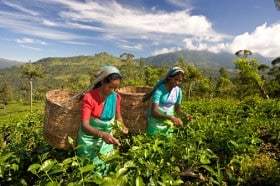Your basket is currently empty!
Ceylon Teas
Ceylon teas: an insight into its history and growing.
 Ceylon teas were planted in 1867, in what is now Sri Lanka, after a coffee blight wiped out all the coffee plantations on the island. Since then Ceylon tea (as it is still known) has not looked back. Sri Lanka is the world’s third largest tea producer and exports account for 19% global demand for tea. Ceylon tea is famed for its brisk, clear, fruity and fragrant tasting black teas. They tend to be self-drinkers – not requiring blending to ensure market appeal.
Ceylon teas were planted in 1867, in what is now Sri Lanka, after a coffee blight wiped out all the coffee plantations on the island. Since then Ceylon tea (as it is still known) has not looked back. Sri Lanka is the world’s third largest tea producer and exports account for 19% global demand for tea. Ceylon tea is famed for its brisk, clear, fruity and fragrant tasting black teas. They tend to be self-drinkers – not requiring blending to ensure market appeal.
History
Coffee Rust, much feared by plantation owners, devastated 100,000 acres of coffee crop in the Central Highlands. Initially planters turned to the production of quinine in the fight against malaria but over-supply eventually led to this market going bust. Other crops such as cacao were experimented with.
James Taylor, a Scotsman, arrived in Colombo at the age of 16 and worked as a superintendent at the Loolecondera Estate in Kandy. He planted Assam tea seeds gained from the Royal Botanical Gardens on 19 acres of land and aimed to achieve more authentic China character. By 1885 he was cultivating 300 acres of tea and had devised mechanical rollers for his tea. This commanded especially high prices. The first auction of Ceylon tea was held in London in 1878. By 1889 28 million pounds of tea was exported to Britain. Succulent buds of Ceylon teas commanded enormous prices and a search for such teas brought Thomas Lipton teas to record prices and fame. Even today he is still synonymous with black tea in Sri Lanka.
Where Ceylon teas are grown
Most teas are grown in the beautiful south western part of the island where rich jungle remains on the steepest slopes and waterfalls shine in the strong sunlight. At elevations of 3,000 to 8,000 feet rainfall is between 45 and 70 inches each year. There are many variations in microclimate such as temperature, rainfall, humidity and wind which influence the character of the individual tea gardens. Whilst the first teas are picked from June to August teas can be picked year-round.
After experimenting with CTC (Cut Tear Curl) methods of production for the teabag market it was found that Ceylon teas could not compete with Indian and East African teas due to the labour required to harvest Sri Lanka’s steep terrain. Many tea factories have therefore converted back to orthodox tea production. Sri Lanka has now regained its worldwide reputation for its flowery, flavourful orthodox Ceylon teas. The best teas sold are graded OP or FOP (Flowering Orange Pekoe). Broken grades are denoted BOP.
Today around a million people are employed in one thousand tea gardens. The local Sinhalese people declined to work on the plantations so the workforce has largely been Tamils who originally came over the Palk Strait from southern India.
Broadly, there are three zones of tea production: high grown, medium and low grown teas. Nuwara Eliya is hot and humid and is the highest area of the central mountains. It tends to produce teas with the most character. Dimbula is situated to the west of these central mountains with Uva to the east. Kandy is the lower altitude area to the north. It is the high grown teas from 3,500 to 7,500 feet that tend to have the most distinctive character and tastes.
Nuwara Eliya
The best of these high-grown teas are picked in January to March. They are fragrant, bright and delicately perfumed with aromas of peaches and apricots. The liquor tends to be mellow and golden.
Dimbula
This area of medium elevation again produces the best teas in the dry season during the first three months of the year. Taking the full brunt of the monsoon Dimbula teas are renown for their good body and strong aroma.
Uva
Subjected to a different weather system to other areas. The best Uva teas are picked between June and September. The finest of these teas are known to be mellow with good, concentrated taste and aroma. This is brought about by the strong easterly winds which cause the tea leaves to close up to protect themselves from these drought-like conditions.
Kandy
This mid-level area is located near the ancient capital Polonnaruwa. It produces a strong tea the most notable pickings being in February and March.
The cup that cheers
Ceylon teas are always picked as a flush (two leaves and a bud). This attention to traditional orthodox tea production and the perfect growing conditions present in Sri Lanka have ensured that Ceylon teas continue to be much in demand for their clarity, richness of flavor and wonderful floral aroma. The long standing advertising slogan of the Ceylon Tea Board is apt when it describes the island’s teas as ‘The cup that cheers’.
Visit the Ceylon Teas section of our Tea Store.
Return to the Home Page of our blog.
Visit the Home page of our website.
